A number of countries, including Russia, Armenia and Germany, have helped supply technology and raw materials used in Syria's chemical weapons programme, including the production of sarin gas, Mediapart can reveal. Syrian experts who worked on the programme and who are now in exile have described how young scientists were sent to train in the former West Germany to learn how to run chemical production facilities. They also claim that one Germany company that supplied raw materials for the Syrian regime “cannot not have known” that they were destined for use in chemical weapons. These latest claims follow revelations from Mediapart via those same scientists that dictator Bashar al-Assad first made plans to use chemical weapons against his own people in 2009 – two years before the start of the civil war.
It was during the 1980s that the Syrian regime decided to begin production of the deadly nerve agent sarin. Before that production began, the only chemical weapons available to Damascus were a small stock of mustard gas and sarin it had been given by Egypt, after the October 1973 Arab-Israeli war. Egypt had used mustard gas against royalist partisans in the 1962-1970 North Yemen Civil War.
But the then-president Hafez al-Assad, who ruled Syria for almost three decades from 1971 to 2000, decided that his country should not rely on another Arab state for such a sensitive weapon, but instead have the capacity to create a chemical weapons arsenal of its own using technology and base products provided from countries which did not threaten its independence. Which is why, during the 1970s, carefully-selected Syrian chemists who had studied in West Germany were sent back to laboratories and research centres there where they were to learn about industrial chemical production techniques and the development of neurotoxins. This cooperation programme between West Germany and Syria lasted until 1983.

Enlargement : Illustration 1
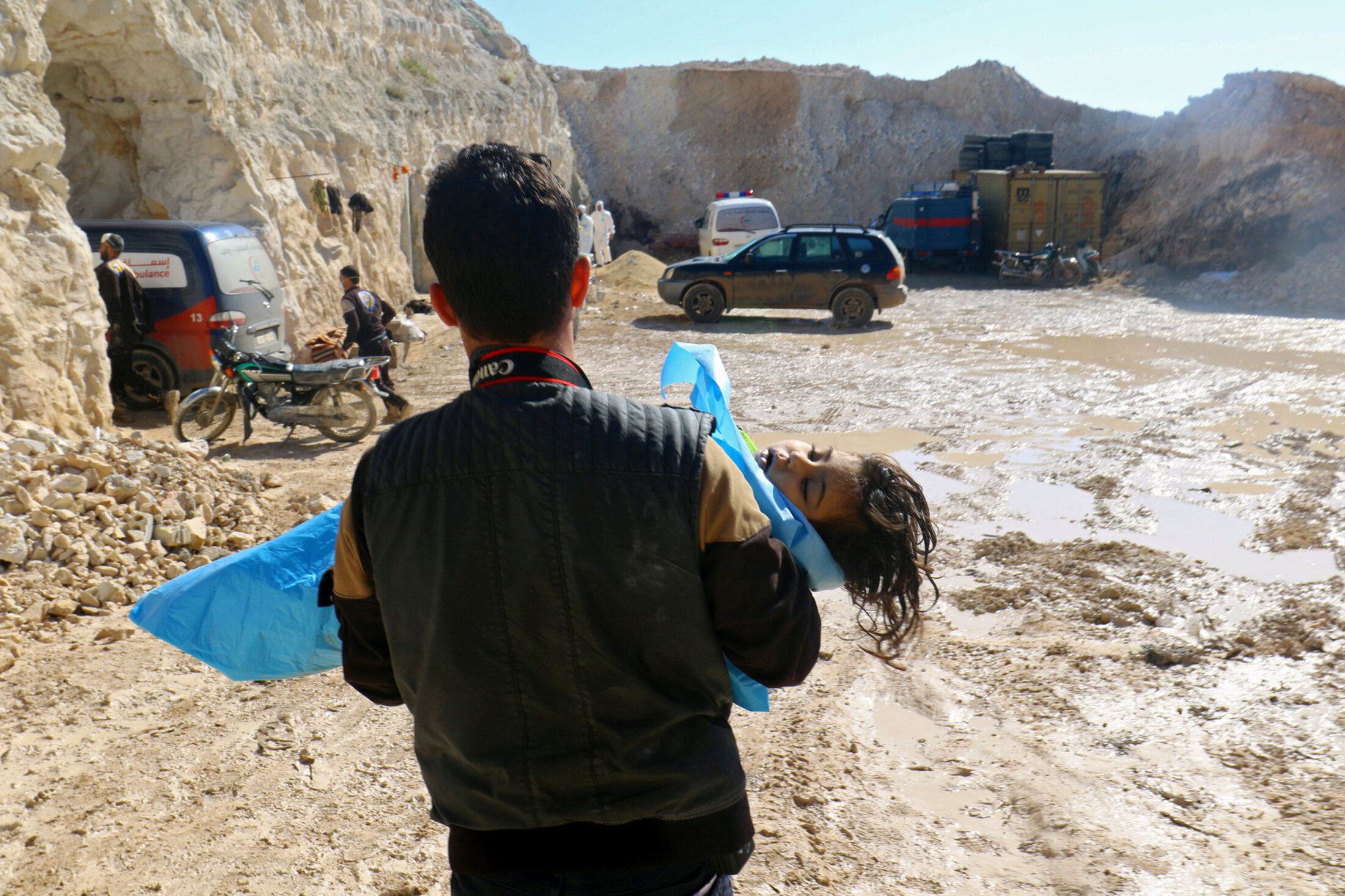
“When the sarin project began, all the researchers who worked on it had been trained in Germany on the assembly of the production line,” said one of the Syrian scientists interviewed by Mediapart.
The reason that Damascus turned to West Germany was, according to those knowledgeable of the programme interviewed by Mediapart, because of the high esteem for German scientific and industrial expertise. But another reason invoked by experts on Syria is the influence wielded over the Syrian secret services by the war criminal and former senior SS officer Alois Brunner, who in 1954 fled Europe for Syria, via Egypt. Brunner, held responsible for the deportation to concentration camps of more than 120,000 Jews, and who was notably the commander between 1943-1944 of the Drancy internment camp near Paris, from where nearly 24,000 people were deported to death camps, is believed to have been handed a role as an advisor to the Syrian regime soon after arriving in the country, where he is reported to have died in 2001.
It appears likely that it was at the behest of the Syrian scientists who were trained in West Germany for the sarin production project that, in order for them to be able to work with methods and installations they had become familiar with, Syria’s Scientific Studies and Research Centre (SSRC) chose German companies to supply all the technology for the local manufacturing of sarin. This included the glassware for the production lines and the containers used for stocks, the blueprints for the production process, and the raw materials.
Several of the exiled Syrian scientists questioned by Mediapart said it was German glassmaking firm Schott which provided the glassware needed for the sarin production. In an interview with The Wall Street Journal in 1988, following reports that Schott had played a role in the production of chemical weapons in Syria, a representative of the company admitted it had sold equipment to Syrian clients but denied knowing what purpose its products were to be used for. Questioned by Mediapart, a person familiar with the type of equipment Schott had sold to Damascus, said it was “impossible” that Schott was unaware of the intended purpose. “They could not have not known what this equipment would be used for,” he said. “Any chemist could have guessed it.”
But as for the equipment supplied by German group Heraeus and Austrian glassmaker Riedel, it could have been for use in any kind of research centre or by any producer of chemicals for civil purposes. As for the substances supplied to Syria by German chemical and pharmaceutical giant Merck, the Syrian scientists questioned by Mediapart said they were “category 3” chemical components, meaning they acted like precursors of precursors, which were not components of sarin but represented ingredients it could be made from – as well as also a number of inoffensive products. Merck could therefore have not known what the ultimate purpose was. In any case, the West German secret services showed little interest in the exports to Syria that lasted over a period of almost two decades, to the evident satisfaction of the Damascus regime. The preference for German products by chemists from Syria's SSRC continued well into the new century.
On August 21st, 2013, rockets containing sarin were launched against the opposition-held Ghouta area of the Damascus suburbs when, according to official US estimates, more than 1,400 people were killed and thousands of others contaminated, prompting ultimately aborted plans for international military intervention against the regime of Bashar al-Assad. In response to a question lodged by Germany’s Die Linke ('The Left') party following the massacre in Ghouta, the German economy ministry formally admitted that chemical products, notably sodium fluoride and hydrogen fluoride, which can both be used to produce sarin, were exported to Syria during the previous ten years. Neither former chancellor Gerhard Schroeder, nor his successor Angela Merkel, opposed the shipment by German firms to the Damascus regime of, respectively, 40 tonnes of chemical products between 2002-2003 and of 87 tonnes between 2005-2006.
Syria’s sarin stocks represented the first modern combat gas that the country had produced by itself, synthesized during almost 30 years in the laboratories of the SSRC. The production involved no major innovation on top of the blueprints imported from Germany. According to chemists who were involved in the project, sarin is extremely difficult and dangerous to produce.
The two precursor compounds can be stocked in the same site without presenting a risk to personnel in the event of a fire or a bombing but the ‘recipe’ for making sarin is not within every scientist’s grasp, even for some of the most experienced (and well beyond the means of a terrorist group). It requires a total mastery of every different stage of production, and also of the organophosphorus compounds involved.
In particular, it demands very precise measurements and control of physical conditions, notably that of temperature, both for the use of certain solvents and the manipulation of several products that are dangerous when in large quantities, such as hydrofluoric acid.
Some of the key products for the production of sarin are part of what the chemists at the SSRC call “the five horsemen”. These are substances which have no industrial application in Syria, and which are therefore very difficult to find and import.
Sarin was invented in Germany in 1938 by researchers at the chemical and pharmaceutical conglomerate IG Farben. Its chemical name is isopropyl methylfluorophosphate, but was reportedly given the name sarin from the last names of the four scientists who created the formula, Gerhard Schrader, Otto Ambros, Gerhard Ritter and Hans-Jürgen von der Linde. Sarin is the result of the reaction of the industrial alcohol isopropyl when added to the final precursor methylphosphonyl difluoride (DF), which is itself derived from methylphosphonyl dichloride (DC) in production lines coated in Teflon, a substance which is difficult to source. DF is very stable, is non-flammable and can be destroyed with water. It can be stocked over long periods of time, on condition that it is regularly transferred to new containers, also coated inside with Teflon on account of its high corrosiveness. The containers used by the Syrian chemists were made in Germany but supplied to the SSRC by a Swiss intermediary.
Production facility and test site south-east of Palmyre
In order to neutralize the effects of the acid produced by the reaction of isopropyl on methylphosphonyl difluoride (DF), the Syrian chemists added to isopropyl a base compound, called hexamine, which is not part of the synthesis reaction but which facilitates its occurrence. The use of hexamine is one of the distinctive signatures of Syrian-made sarin.
Another distinctive element of Syrian sarin is diisopropyl methylphosphonate (DIMB), a chemical waste by-product of the synthesis procedure employed at the SSRC. The sarin it produces is a milky, slightly viscous liquid which is almost odourless when pure. If the chemical reaction process from which it is produced was imperfect, it has the smell of old apples. Skin contact with it is fatal, and when it is transformed by dispersion into a gas cloud – such as by using a well-measured explosive charge – it is fatal when inhaled.
Alongside a production facility, the SSRC set up a test site for sarin attacks, where it could measure the required dosage of the nerve agent according to wind strength, temperature, and different types of terrain. The site was located south east of Palmyre, in open desert alongside the main road leading to the border with Iraq. One of the now-exiled Syrian scientists questioned by Mediapart said that when he visited the site he noticed there was a building whose windows could only be opened from the outside. “I asked if it was a mistake,” he recalled. “A colleague told me that it wasn’t, that it was a building in which the gas was tested on prisoners taken from Palmyre prison. And he advised me to forget what I saw and heard. This building no longer exists. It was destroyed, like the rest of the site in 2013, after the Russian and American agreement.”
From a military point of view, the problem with the Syrian-made sarin is its instability. In its final state, it can only be kept for a few days before it produces a gas that builds pressure inside the projectiles used to launch it. This meant that stocking the weapons was very risky. As a result, each air force base from where planes loaded with sarin bombs would take off included stocks of precursors and a site for preparing the munitions.
It also meant that engineers from the SSRC also had to design bombs that were specific for sarin, and which were quite different to ordinary munitions. “On the outside, they resemble conventional bombs of 250 and 500 kilos of TNT,” explained one of them. “But inside they were totally different, divided into two compartments. The first, at the front, carried the DF. The second, at the rear, [contained] the isopropyl and hexamine. This mixture is stirred together by a stirring rod that can be activated by sort of crank at the rear of the bomb. When the two compartments are filled up, a technician winds the crank which advances the stirring rod to the point it breaks the wall of mica.”
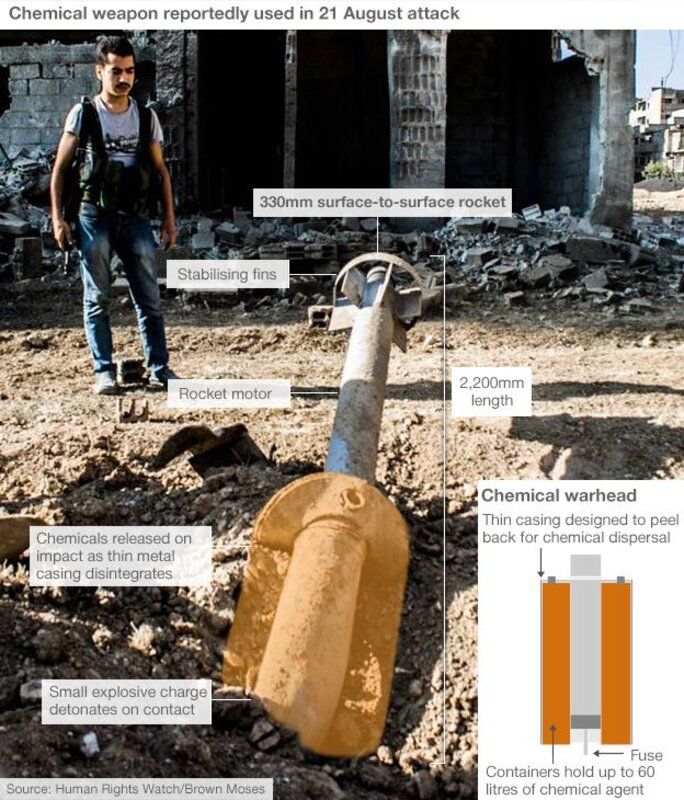
Enlargement : Illustration 2

“The sarin synthesis reaction is set off inside the bomb, placed under a cold shower and maintained within a very precise temperature range which is controlled by a laser thermometer,” continued the former SSRC source. “After which, all that’s left is to introduce, in the allocated hold at the point of the bomb, the explosive charge and detonator – altimetric, chronometric or other – and to place the bomb under the wing of the plane. The load must be very precisely measured. If it is too big, the heat given off can cause the decomposition of the product, or the formation of a cloud of gas too far from the ground, which would render it ineffective. In principle, a 250-kilo bomb contains 133 litres of sarin, a few kilos of TNT and a ballast to preserve the aerodynamic characteristics of the weapon. A 500-kilo bomb contains 266 litres of sarin. The ideal altitude for the explosion of the bomb is about 60 metres.”
Given that a very tiny dose of the gas is fatal, and that those who do survive a contaminated area can be left with lasting neurological damage, one can imagine the consequences of such a weapon being dropped over a densely-populated zone, and the terror it can cause to neighbouring populations. According to the Syrian opposition leaders engaged in the peace negotiations in the Kazakh capital Astana and also Geneva (which up to now have proved a stalemate), the use of sarin bombs plays a key role in Bashar al-Assad’s strategy for displacing populations.
Over a period of almost ten years, following the construction in the early 1980s of the first sarin production centre close to the town of al-Dumayr, about 40 kilometres north-east of Damascus, the SSRC’s “department 3000” produced hundreds of tonnes of sarin that were stocked in an inert state, in the form of liquid DF precursors and isopropyl. The stockpiles required constant surveillance. Not because sarin gas could be released accidentally – such an occurrence would be impossible - but because the two substances can be destroyed or deteriorated from contact with water and water vapour, and the Teflon-coated recipients containing the DF, which are scarce on the market and costly, must be regularly checked.
Gulf War turning point
Towards the end of the 1980s, some of the substances required for the making of sarin became very difficult to source, for reasons unclear to the Syrian chemists questioned by Mediapart. As a result, the chemists in the SSRC’s department 3000 turned to making another nerve agent, a synthetic chemical compound called VX. Invented by British chemists in the early 1950s, VX is ten times as deadly as sarin, and far more stable. It is produced as an oily liquid that can be dispersed by air or water. The Syrian regime were able to buy its synthesis blueprints and its main components or precursors from Armenia at a much lower price than that demanded by the Soviet Union, which the SSRC had decided was prohibitive.
VX was produced for several years at a camouflaged underground site close to the town of An-Nabek, about 75 kilometres north-east of Damascus.“During a test dropping of VX grenades by helicopter above a zone which the military had emptied and cordoned-off, the munitions which were supposed to explode at an altitude of 60 metres exploded at 400 metres,” recounted one of the Syrian researchers interviewed by Mediapart. “The wind, which was quite strong at that altitude, blew the cloud 25 kilometres away from the intended zone and a flock of sheep was wiped out. The government paid compensation to the owner [of the sheep], explaining to him that it was a failed test of a plant disease control product.”
The 1990-1991 first Gulf War put a temporary end to the stockpiling of VX. While the Syrian regime of Hafez al-Assad had allied itself to the US-led international coalition against the Iraqi regime of Saddam Hussein, al-Assad was, according to several of those knowledgeable of the situation, fearful that US aircraft would bomb sites producing and stocking chemical weapons in the region, including those in Syria. Realising the enormous danger that the dispersion of VX in the atmosphere would represent to both the Syrian military and the civil population, al-Assad ordered a halt to production of the nerve agent and the dismantling of the laboratories involved.
Two years later, when a reassured Hafez al-Assad decided that production could recommence, market conditions had changed. The components for the weapon, which came from several sources, were more and more expensive. So the SSRC undertook to produce them themselves, from imported raw materials.
Production resumed at An-Nabek. But department 3000 lost its leader when director Ayman Habal was arrested by the intelligence agency the mukhabarat, who suspected him of corruption. In fact, Habal was not corrupt but was a CIA informant, and thinking he was being interrogated about this he admitted his links to an American agent of whom his inquisitors were entirely unaware. He was executed on April 11th, 2002.
In that same year the production of VX was halted because of a shortage of raw materials. The build up to the impending American operation against Iraq and the search for weapons of mass destruction had thrown such a spotlight on the potential ingredients for chemical and biological weapons that there was a real shortage of them.

Enlargement : Illustration 3
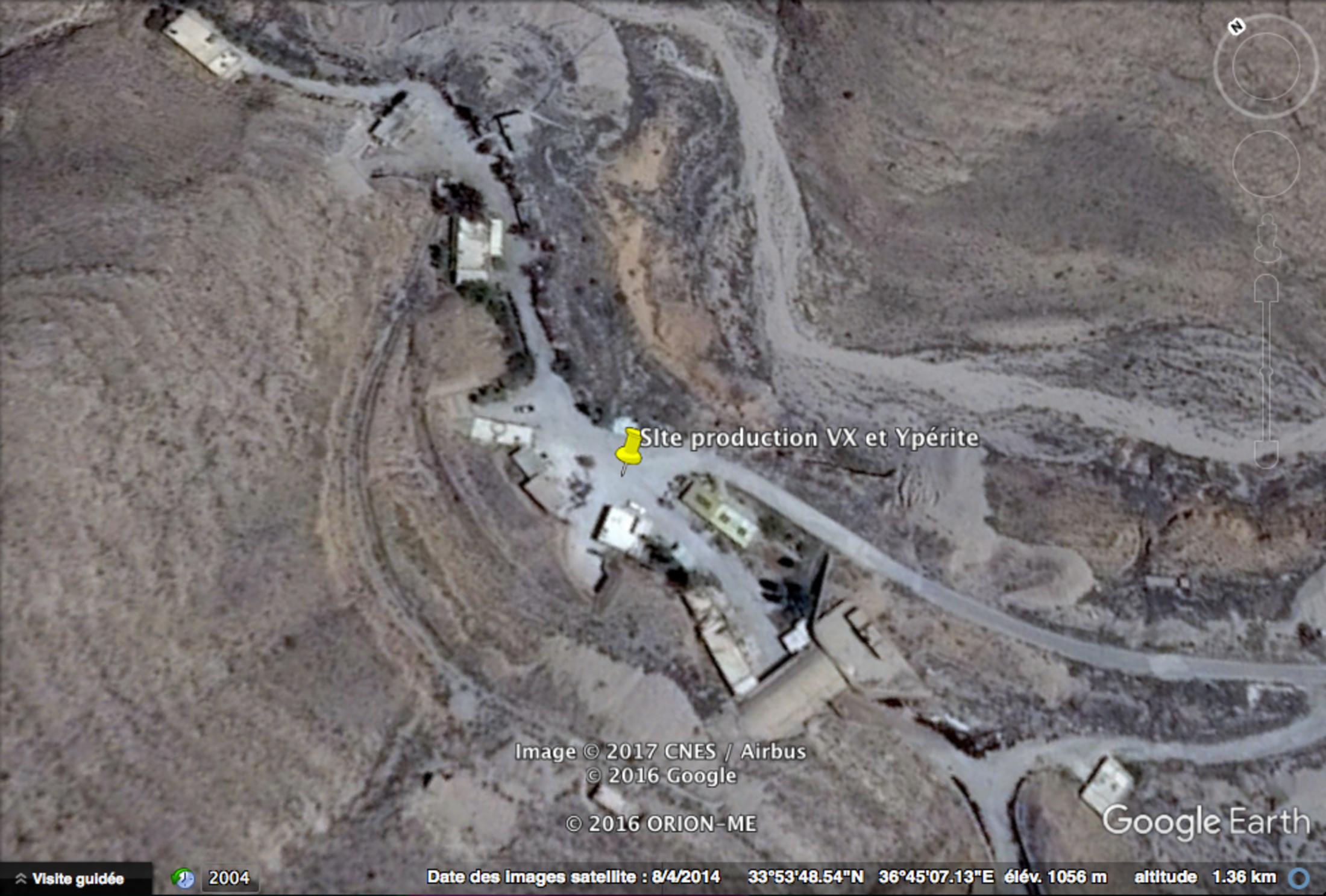

Enlargement : Illustration 4
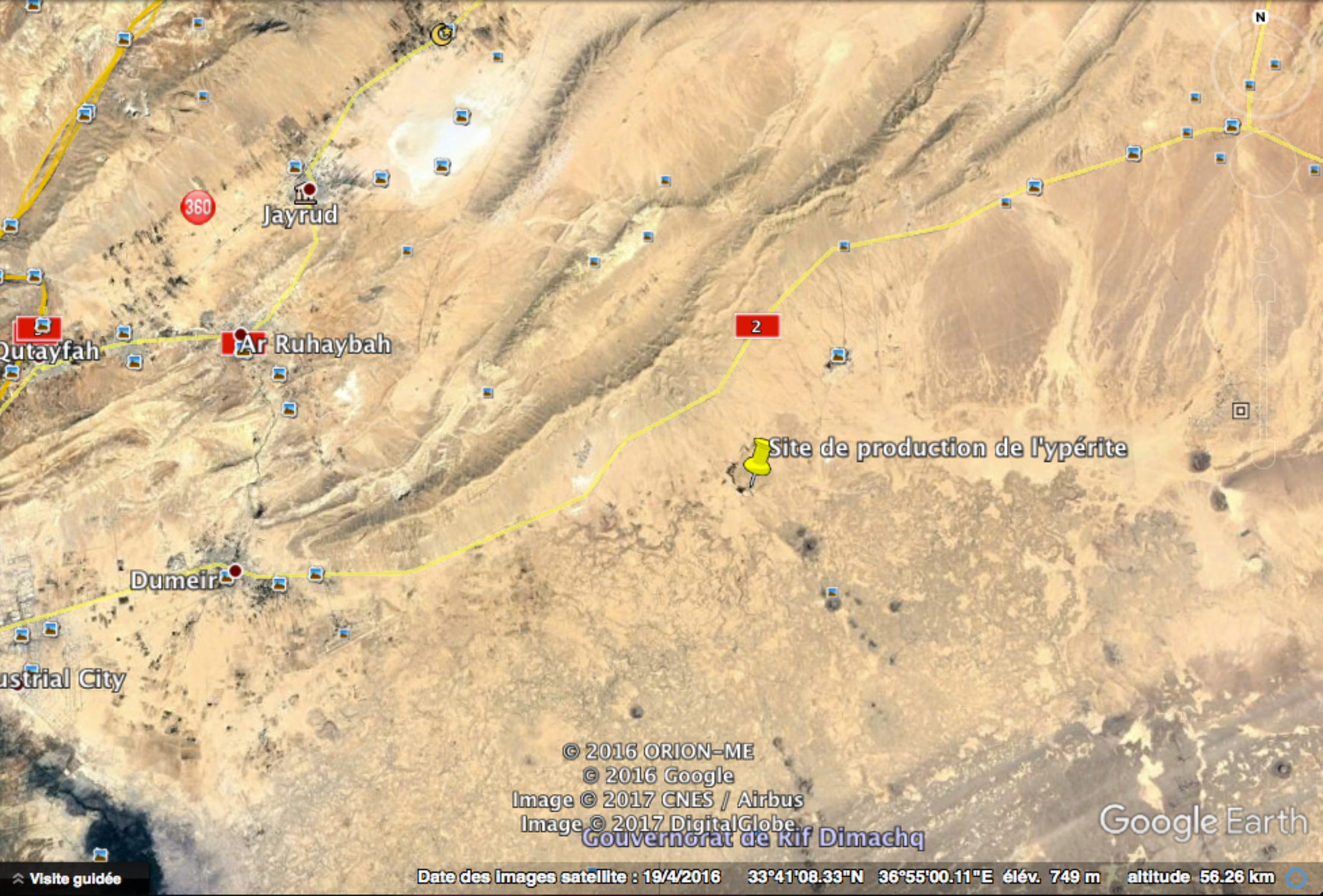

Enlargement : Illustration 5
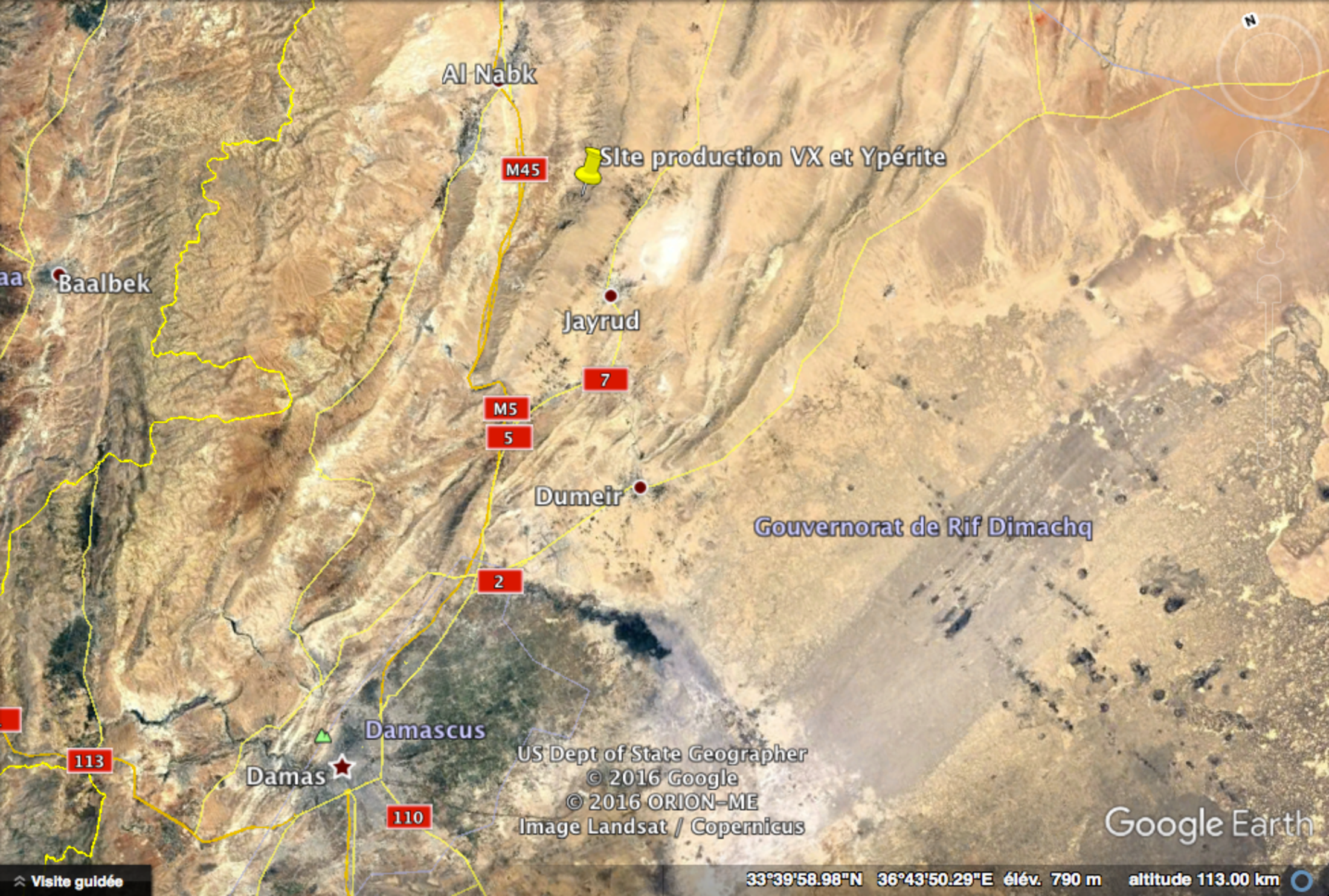
Using its now lengthy experience with neurotoxins, the SSRC replaced VX with mustard gas - used in warfare as long ago as World War I - and which was made at its secret factory at An-Nabek until 2007. The raw materials to make it were not to hard to find. One of them, sodium sulphide, is used in tanneries. The other, glycol, is one of the components of the antifreeze used in cars. They both belong to what chemists call 'category 3' materials: products that are impossible to ban. Syria sourced its sodium sulphide from Iran, its hydrochloric acid from Pakistan and glycol from Holland.
More than a thousand tonnes of chemical weapons in 2011
When Bashar al-Assad came to power in June 2000 his army had several tonnes of poison gas: sarin, VX and mustard gas. But the Syrian military considered sarin to be problematic as a tactical weapon: it evaporates easily, its effectiveness depends on the temperature, wind speed and the terrain on which it falls. This variable efficiency complicates its operational use. Mustard gas is much less lethal than sarin but from a military point of view is more useful on the battlefield because it causes a large number of incapacitating injuries and wounds. For an enemy army the collection of its dead requires far fewer soldiers than caring for its wounded, each of whom requires two or three stretcher bearers and first-aiders.
For all these reasons, and for others linked to the excessive national pride of Bashar al-Assad and his clan, at the start of 2003 Syria abandoned its chemical weapons programme in favour of the nuclear reactor that the North Koreans were starting to build at Al-Kibar, near Deir ez-Zor in the east of the country. In the mind of Syria's leaders this reactor was supposed to be the heart of a nuclear programme which in time would lead to the production of a nuclear weapon. Even if that prospect was some time away, this was a risk that the Israeli general staff did not intend to run. Just before midnight on September 6th, 2007, Israeli F15 and F-16 fighters neutralised the region's radar and anti-aircraft defence and destroyed the reactor under construction, killing ten North Korean technicians.
The order went out to the SSRC to resume the chemical weapons programme and the VX production centre started up again. This time the scientists at department 3000 were working with a new production method that they had developed and which allowed them to produce the gas with products that were easy to source, enabling them to “make the best of what they had”. The glassware was bought from the Indian firm Garg. The first delivery arrived without any hitch and was used in production. The following shipment, in 2008, was intercepted by the United States who warned the Indian government. But the Syrian production lines continued to function.
When the popular revolt against the dictatorship broke out in 2011, the regime's storage centres contained more than 1,000 tonnes of chemical weapons. “We had 700 tonnes of sarin, 100 tonnes of VX, 263 tonnes of mustard gas, enough to arm 3,000 bombs and around a hundred Scud warheads,” says one of the scientists spoken to by Mediapart. “We also had chlorine, ricin, produced from seeds [from the castor oil plant] that we grew near Latakia. In the past the institute had even made BZ. This is a hallucinogen which is far more powerful than LSD, which was developed at the SSRC and made available to the mukhabarat for their interrogations. We designed two sprays, one 50ml, the other 100ml. It was a very effective product. Its effects stopped after a certain time but it could cause lasting psychological damage after around a hundred doses. A SSRC employee who worked on this product went mad.”
To carry its poison gases the Syrian army had, until 2010, two options: 250kg and 500kg conventional bombs, adapted to disperse chemical weapons and dropped by Sukhoi 22 fighter-bombers and Mig 23s; and the warheads on ground-to-ground Scuds with a range of 300 to 700km, supplied by North Korea or made in Syria, and which were capable of carrying up to 450kg of sarin or VX. The order given by Bashar al-Assad in 2009 to the SSRC to plan a 'domestic' use of sarin gas and to design munitions and carriers adapted for this use was to give the army a much larger and more sophisticated arsenal. According to one former SSRC employee the air force even had guided bombs.
So as well as bombs and missiles there were grenades that could be thrown from helicopters and a range of missiles and rockets, either imported from Russia such as the SS-21 with a range of 70km to 185km or made in Syria and based on Iranian technology, like the M-600 'Fateh', with a range of 250km. Some Syrian devices were even improvised from existing weapons. The ground-to-ground '330' rocket which can carry 40kg to 60g of sarin is made from a large 330mm diameter container fixed on a 122mm rocket which contains the propellent.
“To launch these rockets,” says a Syrian engineer, “the SSRC designed a special launch ramp fixed to the back of an all-terrain lorry. Trucks made in Turkey under an American licence were bought via an intermediary as building site vehicles. A salvo of around ten of these rockets were fired at Ghouta on August 21st, 2013, causing close to 1,500 deaths.” After that massacre - which was a clear violation of the red line drawn a year earlier by Barack Obama - France, the United States and the United Kingdom were on the verge of launching punitive air strikes against strategic Syrian sites. The operation was called off at the last minute after the British Parliament voted against action and because of Obama's refusal to act without the support of the US Congress and British involvement.
This episode, which the democratic Syrian opposition still recalls with bitterness, was followed by a Russian-American agreement concluded in Geneva on September 14th, 2013, at the end of which Syria committed itself to abandoning its chemical arsenal and allowing its stocks and production facilities to be destroyed under the monitoring of Washington, Moscow and the United Nations. It also agreed to ratify the 1993 Convention – which came into force in 1997 – on the “Prohibition of the Development, Production, Stockpiling and Use of Chemical Weapons and on their Destruction”.
In June 2014 the Organisation for the Prohibition of Chemical Weapons (OPCW) indicated that 92% of Syrian chemical weapons had been destroyed and that the remainder had been assembled on one site but could not yet be removed for security reasons. But had Syria really agreed to dismantle all of its stockpile? The answer, according to the Syrian scientists spoken to by Mediapart, is no. In 2015 around ten chlorine gas attacks were recorded by Amnesty International. According to a former SSRC employee chlorine – which is very cheap and easy to find as it is the chemical agent used everywhere in the world to treat water – was and still is used today as a replacement for sarin. It is easy to transport and there is no need to stock it as all water treatment plant have canisters of it.
In its 'National Evaluation' released in April 2017, and which used information from the intelligence services, the French Foreign Ministry states that more than a hundred instances of reported chlorine use have been recorded since Syria signed up to the ban on chemical weapons in October 2013. The three last observed uses of chlorine date back to January and February 2017. In the same document Paris says that since 2014 Syria has been trying to acquire “several tens of tonnes of isopropanol” and that it had “not declared to the OPCW some tactical munitions (grenades, rockets) of the type used repeatedly since 2013”.
“In fact,” confirms a former SSRC employee, “though it signed the United Nations Convention to meet the demands of Moscow and Washington, the regime has never renounced the use of chemical weapons. It has even, since 2013, amassed a veritable secret chemical arsenal. By explaining to [weapons] inspectors that certain production or storage sites were inaccessible because of the fighting, by systemically overestimating losses due to leaks, destruction by water or in tests, and by producing falsified stock inventories, those in charge of department 3000 took away enough gas to kill people and provoke terror. We estimate the amount of gas diverted to be 35 tonnes.”
On May 23rd this year the High Representative for Disarmament Affairs, Izumi Nakamitsu, told the UN Security Council that 24 of the 27 production plans for chemical weapons notified by Syria had been destroyed but that the “prevailing security situation” continued to prevent safe access to the three remaining sites, including an aircraft hangar. She also gave the results of the investigations carried out after several “incidents” between September 2016 and April 2017. She concluded that poison gas had been used, apparently from stockpiles hidden by the regime.
Just a tiny part of this clandestine stockpile was used – with complete impunity – to attack Khan Shaykhun on April 4th, 2017. That bombing was followed by a largely symbolic reprisal strike by American cruise missiles. The war then resumed its bloody course, punctuated by short-loved ceasefires and truces, movements of people and diplomatic manoeuvring aimed at some undefined future resumption of talks.
In the face of all the evidence, and more determined than ever to defend his power and his regime, Bashar al-Assad has continued to deny any responsibility for the use of sarin and also for the bombing of hospitals. This raises a new question for observers. Does one still have to ask whether a leader who has not hesitated about killing more than 300,000 of his fellow citizens to save his regime can be part of a solution to the crisis? Or if a dictator cynical and barbaric enough to maintain a clandestine industry to massacre and gas his own people can have any place, even through an intermediary, at the negotiating table?
-------------------------------------------------------------------------------------
- The French version of this article can be found here.
English version by Graham Tearse and Michael Streeter


